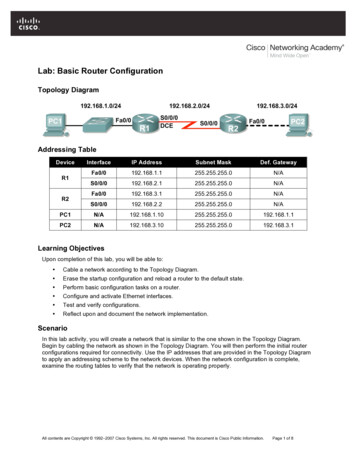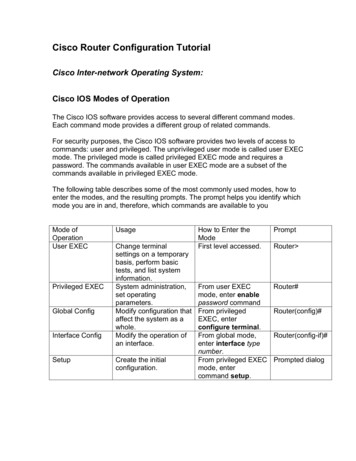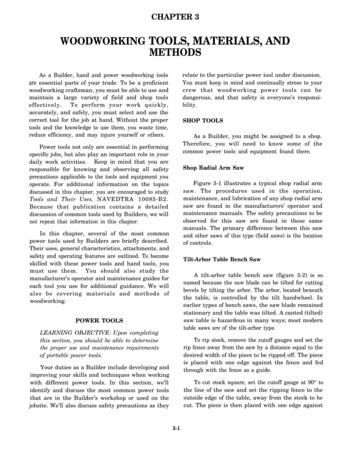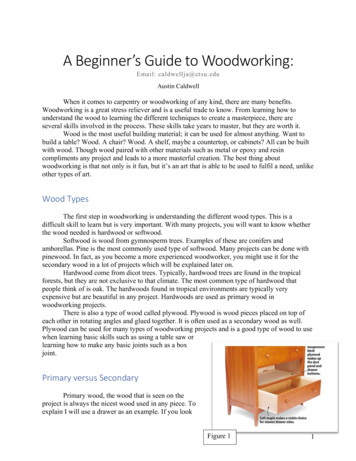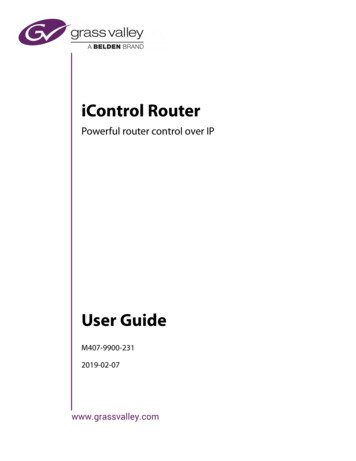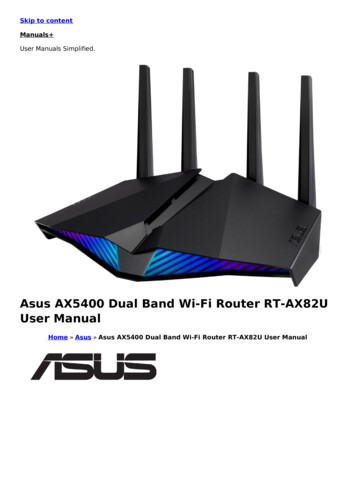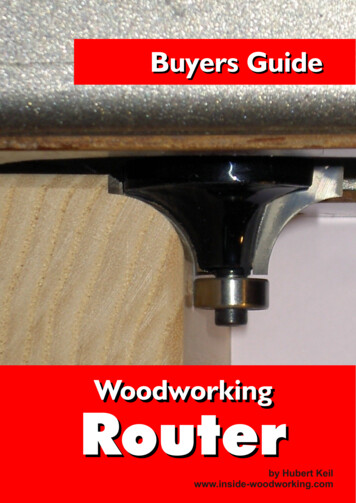
Transcription
Buyers GuideWoodworkingRouterby Hubert Keilwww.inside-woodworking.com
The Router Buyers GuideWelcome to the Router Buying Guide!For many years, we have been answering questions concerning power toolsand woodworking machinery. One of the most frequently asked questionsabove all, has always been related to routers.Being amongst the most versatile tools in a cabinet makers workshop, it isalso one of the most sophisticated machines. With this litte router buyingguide, we want to give you a basic overview on what to look for when youpurchase a router.Have fun and discover the world of woodworking routers!Hubert Keilwww.inside-woodworking.comWith over 20 years of experience as a cabinet maker, Hubert Keil worked for various woodworkingmachinery distributors and power tool manufacturers in Germany, England, Italy and Spain.Amongst them, Fortune 500 companies such as Black&Decker (DeWalt,PorterCable) and wellknown router equipment supplier such as Leigh Industries.He is the founder and editor of The Inside Woodworking Magazine; an online publication onwoodworking and machinery related topics.-2We try to keep this info sheet up-to-date. If you find that any address has changed, please let us know. However, as a general comment, allow us to mention that the views, statements and informationexpressed on the www.inside-woodworking.com web site or publication represent the opinions of the authors. The authors do not assume any liability for the information contained herein.www.inside-woodworking.com 2003 - 2006 by www.inside-woodworking.comAbout the Author
The Router Buyers GuideWhat to look at when purchasing a woodworking router?4Handles and Motor Power5Motor Power - 1hp, 2hp or above?6Variable Speed Control7Collet Bit Sizes8Router Bit Types9Most important Parts of a Router10Accessories11Recommended Resources and Suppliers12-3We try to keep this info sheet up-to-date. If you find that any address has changed, please let us know. However, as a general comment, allow us to mention that the views, statements and informationexpressed on the www.inside-woodworking.com web site or publication represent the opinions of the authors. The authors do not assume any liability for the information contained herein.www.inside-woodworking.com 2003 - 2006 by www.inside-woodworking.comIndex
The Router Buyers GuideWhat to look at when purchasing a woodworking router?The router is certainly one of the most versatile power tools used in woodworking. It's an essentialmachine in today's workshop and becoming increasingly useful to the woodworking beginner.In this book we want to cover all the important parts and aspects of a modern router and what youshould look at before you purchase a new one.Two different types of RoutersThe different types of routers available, we can basically separate them into two categories:Plunge RouterFixed Base RouterWhile the fixed base model is simply speaking about a motor with a base plate attached to it, theplunge router allows the motor to be moved in and out of the wood.Which one is used for what?What's better - fix base or plunge router?Generally speaking, in normal woodworking, using plunge router models are the best choice, asthey are more versatile in use. The only exception I could think of would be in high precision guidebush related work (e.g. using a router on jig), where you use the router strictly in a fixed position.Here, the fixed base models have a certain advantage in centricity of the guide bush vs. thebase due to less movable parts.-4We try to keep this info sheet up-to-date. If you find that any address has changed, please let us know. However, as a general comment, allow us to mention that the views, statements and informationexpressed on the www.inside-woodworking.com web site or publication represent the opinions of the authors. The authors do not assume any liability for the information contained herein.www.inside-woodworking.com 2003 - 2006 by www.inside-woodworking.comA fixed base router is by design, limited to edge routing and cutting in from outside towards theboard. Allowing everything except cut out and dive in cuts.The plunge router models can be used as a fixed base router, by simply fixing the motor on theplunge bars, but can also be used to cut into the wood using the plunge mechanism.
AlicanteTheRouterSightseeingBuyers GuideHandles and Motor PowerDifferent HandlesAs with different types of routers, the different handles available are also of importance. Thestandard double knob handle on either fixed base or plunge routers covers most applicationsbest. Especially when you do grove cutting and freehand signage routing, the two parallel handleknobs are an excellent choice.The alternative D-handle grip mostly found on some fixed base models allows a kind of singlehand movement. Similar to the pistol grip on some edge and plunge routers, the woodworker cancontrol the router more easily along the edge of the board. Especially for edge trimming work, thepistol grip routers give you an advantage of easy handling.D-Handle GripDouble Knob HandlePistol GripMotor Power - 1hp, 2hp or above?The simple answer " the more the better " is NOT working here. Let's look at what we are talkingabout here. Generally speaking, routers can be divided into 3 groups:! 1hp to 2 hp (800 - 1600 Watt)! Above 2 hp (1600 Watt and above)-5We try to keep this info sheet up-to-date. If you find that any address has changed, please let us know. However, as a general comment, allow us to mention that the views, statements and informationexpressed on the www.inside-woodworking.com web site or publication represent the opinions of the authors. The authors do not assume any liability for the information contained herein.www.inside-woodworking.com 2003 - 2006 by www.inside-woodworking.com! Up to 1hp (800 Watt)
The Router Buyers GuideMotor Power - 1hp, 2hp or above?The light - 1 hp - RouterLet's just call these models 1hp models for simplicity; even some of them might have up to 1000Watts. These routers are the perfect model for edge trimming and most routing jobs. The routerusually fits router bits with shank dia: 8mm allowing e.g. to cut grooves up to 20-24 mm wide. Thevery low end units in this category (up to 500 Watts) usually only take ¼" or 6mm shank diam. andare really only of use for very limited edge trimming or a bit of DIY work.The medium - 2 hp - RouterThis is the standard category for most professional router models. The difference betweenthe 1hp and this class is foremost the collet size. On 2hp models you should be able to fitrouter bits with ½, 12,7mm and 12mm as well as the smaller 8mm and ¼ bits. Being ableto fit bits with these large shank diameters and the motor power allows you to cut e.g.grooves in width of up to 30 mm in one pass.These 2hp models are the most versatile routers, but has the disadvantage of a higherweight compared to the 1hp routers. Especially when doing lots of edge trimming, youmight consider a lighter unit.The heavy - 2hpPLUS - RouterThese very heavy duty units, and I am not referring to precisely more than 2hp, are mostoften used for industrial applications and staircase building. Most of the units haveespecially large collets which allow shanks diameters of 16mm or bits with thread M16x1,5to be used.These models sometimes even come with 380 Volt motors, allowing them permanent workon fixed dovetail jigs or overhead routing tables. Their use for portable routing applicationsis rather limited, due to its heaviness.If you start woodworking and especially using a router, you are almost certain to go with alight 1hp router model using 8mm shank size cutters. These units are perfect for edgetrimming applications and allow you to do the basic groove and cutting work. An 800-1000Watt unit would be my first choice.If you are an experienced woodworker or even a professional, than it's really not aquestion of which one you should go for , you really need both types. One 1 hp unit foryour basic edge routing and a 2hp unit for your heavy duty work.-6We try to keep this info sheet up-to-date. If you find that any address has changed, please let us know. However, as a general comment, allow us to mention that the views, statements and informationexpressed on the www.inside-woodworking.com web site or publication represent the opinions of the authors. The authors do not assume any liability for the information contained herein.www.inside-woodworking.com 2003 - 2006 by www.inside-woodworking.comWhich one to choose?
The Router Buyers GuideVariable Speed Control - Collet Bit SizesRouter Speed Control (fix vs. variable speed) - why would I need it?Some router models come with a choice to select a fix speed model or a variable speed version.As the name says, the variable speed models allow you to slow down the speed of the routermotor.Why would you need variable speed?Basically, an electronic regulated variable speed router provides two advantages:- it allows you to adapt the router speed to your wood and router bit used- it maintains the router speed at the same level, even when cutting fast into the grainThe ability to adapt the speed of your router prevents the cutter from burning along the wood, incase you are cutting cross grain at a very low feed rate.In addition, if you are using your router to cut other materials such as PVC or Aluminium, thevariable Speed Option allows you to slow down the motor and adapt it perfectly to the cutterdiameter used.Collet and Router Bit SizeDepending on where you are living, you will find various router models with different collet sizes toallow different router bits to be fitted ."The Metric world"In metric countries you will most likely find these collet and shank sizes:6mm, 8 mm, 12 mm - and occasionally M12x1 and M16x1,5 treadedDrawing exaggerated for better demonstration-7We try to keep this info sheet up-to-date. If you find that any address has changed, please let us know. However, as a general comment, allow us to mention that the views, statements and informationexpressed on the www.inside-woodworking.com web site or publication represent the opinions of the authors. The authors do not assume any liability for the information contained herein.www.inside-woodworking.com 2003 - 2006 by www.inside-woodworking.com"The Inch World"In inch measures you will come across these sizes:¼" (6,35mm) and ½" (12,7mm)
The Router Buyers GuideCollet Bit Sizes - Router Bit TypesThis is just a rule of some, as in recent years 8mm bits become even more standard in NorthAmerica.However, the shank size of the router bit used relates highly to the rigidness and therefore to theoverall size of the router bit. Simple rule of thumb:The bigger the bit shank, the larger the diameter of the cutter can be and the more powerful therouter needs to be.What collet / router bit size to look for?I would try to go for 8mm shank bits if you go for a 1hp router. An 8mm shank diameter offers up to60% more shank surface and therefore even more stability to the bit.In case you are looking for a 2hp router, it depends on which country you live in, use either a12mm or a ½ bit and collet sizes.Router Bit TypesGenerally you can choose from two different types of router bits.! Edge Routing! Groove RoutingDrawing exaggerated for better demonstration-8We try to keep this info sheet up-to-date. If you find that any address has changed, please let us know. However, as a general comment, allow us to mention that the views, statements and informationexpressed on the www.inside-woodworking.com web site or publication represent the opinions of the authors. The authors do not assume any liability for the information contained herein.www.inside-woodworking.com 2003 - 2006 by www.inside-woodworking.comEdge Routing Bits are used, as their name says, for edge routing. Be it a profile or a chamfer orwhatever, they are guided along the edge of the wood; either guided by the router guide fence orby a pin or bearing on top of the router bit itself.
The Router Buyers GuideRouter Bit TypesGroove Routing Bits are used to cut inside a workpiece. Either simple grooves or cut outs ordifferent shapes and profiles. Signage or V-Shape bits also belong to this category.Drawing exaggerated for better demonstrationRouter bits are made out of different materials. The most common ones are HSS and TCT. HSSstands for High Speed Steel and is mostly used to cut soft woods like pine e.g. The harder TCT(Tungsten Carbide Tipped) router bits are used to rout hardwoods (oak e.g.) and plywood or MDFboards.Which bit should I use?If you rout hardwoods, MDF or plywood you have not much choice but to use the more expensiveTCT router bits.If you cut softwood, you can use HSS bits, as they are much cheaper. However, keep in mind thatthey do not last as long as TCT bits.There is one exception to this use which are TCT bits, if you can afford them Rule:In case of cutting softwood or very delicate hardwood which tends to splinter a lot, you should useSPIRAL-UP-CUT HSS (or TCT) router bits. These spiral shaped router bits cut smoother into thewood and prevent it from splintering. Mostly available in plain straight shape, they guarantee thebest cutting results.-9We try to keep this info sheet up-to-date. If you find that any address has changed, please let us know. However, as a general comment, allow us to mention that the views, statements and informationexpressed on the www.inside-woodworking.com web site or publication represent the opinions of the authors. The authors do not assume any liability for the information contained herein.www.inside-woodworking.com 2003 - 2006 by www.inside-woodworking.comException!
The Router Buyers GuideMost important Parts of a RouterRouter BaseWhen looking for a good router, you may pay special attention to the base plate. This area andespecially the surface will be later in permanent contact with your workpiece. You want the baseplate made of a durable material which prevents scratching the surface. Most often plastic, steel orphenol pieces are attached to the base. On excellent routers, these base plates can be exchangedeasily (screws) in case they wear out.I personally prefer phenol base plates as they last longer than plastic inserts.Depth Adjustment and StopMake sure the router has a precise depths stop with fine adjustment capability so you can fine tunethe depth of cut you want. Most routers have also triple or quadruple depth stops which allow, inaddition to fast changes in an different depth of cut. This is very useful if you cut deep cuts invarious instant so you rout step by step a bit deeper.Guide FenceAlmost all routers come with a guide fence so you can cut along the edge of the workpiece.However, it's worth examining the quality of the guide fence carefully as here are some of the mostsignificant differences in quality. A good router guide fence can be firmly attached to the router byone or better two rods through the base plate. Make sure that the fence itself is made of steel oreven better, of aluminium cast in order to be plain and rigid. The part of the fence which touchesthe workpiece should be non-scratching and replaceable, as you so might rout into it accidentally.Some very high quality routers offer additional fine adjustment for the guide fence to fine tune thefence even more.One of the most vital parts on a router is the guide bush system. A guide bush is attached to thebase of the router and allows the machine to be guided along a little recess out of the base plate.You can either make your own templateswhere you guide your router along whilerouting or you can use ready made templatesand jigs for various applications. Mostcommon templates are for staircase building,dovetailing and cutting mortise and tenons.If you examine the guide bush system used ona router, make sure that the bush can be fittedfirmly and cantered precisely to the centre ofthe base. Both things are important if you planto use your router in the future with a jig.- 10 We try to keep this info sheet up-to-date. If you find that any address has changed, please let us know. However, as a general comment, allow us to mention that the views, statements and informationexpressed on the www.inside-woodworking.com web site or publication represent the opinions of the authors. The authors do not assume any liability for the information contained herein.www.inside-woodworking.com 2003 - 2006 by www.inside-woodworking.comGuide Bush System
The Router Buyers GuideAccessoriesDust ExtractionIf you buy a router make sure you check if the toolcomes with a dust extraction adapter where you canattach your vacuum cleaner to it. Especially whenrouting long hours, you will find good dust extractionmore and more important.Guide Rail SystemWith many manufacturers offering guide rail systems mostly for circular saws, there are somerouter manufacturers who also offer thecapability to use your router with a guide railsystem. A guide rail system is simply spoken, analuminium guide (available in various lengthfrom 800 mm to 2400 mm) clamped to yourworkpiece where you hook your saw or routeronto. This way, the tool makes absolutelystraight cuts. In case of a router, it's ideal toperform high precision cut outs e.g. for kitchensinks or door inlays.If you are a bit more advanced with your router, you may well want to use it (upside down) in arouter table. If possible make sure you check before you buy a router as to whether or not yourrouter table is available for your desired model. At least you should check if your favourite routercould be easily attached to one of the most common stand alone router tables on the market.- 11 We try to keep this info sheet up-to-date. If you find that any address has changed, please let us know. However, as a general comment, allow us to mention that the views, statements and informationexpressed on the www.inside-woodworking.com web site or publication represent the opinions of the authors. The authors do not assume any liability for the information contained herein.www.inside-woodworking.com 2003 - 2006 by www.inside-woodworking.comRouter Table
The Router Buyers GuideRecommended Resources and SuppliersInstead of printing directions of router suppliers and manufacturers directly in this ebook, we haveset up a special website to keep this Recommended Resources List book/resources.html- 12 We try to keep this info sheet up-to-date. If you find that any address has changed, please let us know. However, as a general comment, allow us to mention that the views, statements and informationexpressed on the www.inside-woodworking.com web site or publication represent the opinions of the authors. The authors do not assume any liability for the information contained herein.www.inside-woodworking.com 2003 - 2006 by www.inside-woodworking.comPlease click on the webaddress below to find our resource list online:
guide, we want to give you a basic overview on what to look for when you purchase a router. Have fun and discover the world of woodworking routers! Hubert Keil www.inside-woodworking.com The Router Buyers GuiThe Router Buyers Guidede About the Author With over 20 years of experience as a cabinet maker, Hu

